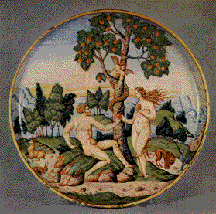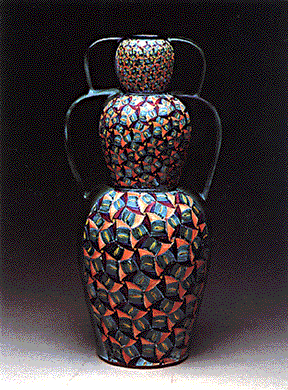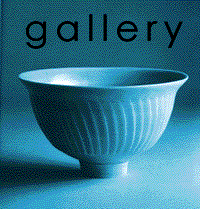OXIDE PAINTING refers to a technique of glazing in which metallic oxides are painted on top of an unfired glaze to achieve color changes and create patterns. Usually, an opaque white glaze is used, however, almost any glaze can be successfully used. What is desirable is a glaze that will not allow the colors to run or bleed. The glaze we use most often for oxide painting here at GCC is OPAQUE WHITE GLOSS. The white color shows off the oxides well, and the glaze is not runny. It is not the only possible glaze, however. Here is a list of suggested glazes to use:
OPAQUE WHITE GLOSS, CLEAR, SATIN WHITE, CELADON, COBALT BLUE, NEWT CAKE, TEMMOKU (use only rutile wash), WINOKUR YELLOW
A WASH is a metallic oxide mixed with water. The most commonly used metallic oxides and their resultant colors are as follows:
COBALT OXIDE - blue to blue-violet
IRON OXIDE - tam to rust-brown
COPPER OXIDE - aqua-green to rose-pink
CHROME OXIDE- intense greens (use thinly)
CHROME + COBALT - blue-greens
MANGANESE DIOXIDE - brown - egglant in color (relatively weak pigment, purples only develop in oxidation firings)
BLACK WASH (actually a mixture of the above) - gray-black
RUTILE WASH (Iron + Titanium) - gold (sounds great, but usually looks terrible on most glazes) USE ONLY ON TEMMOKU!!!
VANADIUM OXIDE - yellows (relatively weak pigment, and used primarily in oxidation firings)
Colors may be mixed, blended, overlapped, stippled, sprayed, brushed or stamped. They must be applied over (not under) a glaze for successful results. Application of oxide washes under a glaze often results in areas of 'crawling,' in which the glaze pulls back to reveal the clay underneath. Chrome oxide and cobalt oxide are especially likely to cause galze crawling when applied under a glaze. Of course testing of application thickness with the oxides is necessary. Wax resist can be used in addition to the oxide washes to achieve layering of design and pattern. Do not smudge colors after application.
Oxide painting can be done at any firing temperature or atmosphere, but of course radically different colors will result depending on the type of firing employed.

THE FALL OF MAN, 1555
Platter, Italian
MAJOLICA refers to a type of pottery characterized by a technique of oxide painting onto an opaque white glaze. Originating in 9th century ware from Persia, the potters of the Middle East were reacting to the porcelains they began to see coming from China along the silk route. Potters tried to reproduce the porcelain process but were not successful. Instead they found that by covering their local dark terra cotta with a white glaze, that it was possible to at least create a white surface to paint on. Thus the invention in the 9th century in Persia of a tin oxide based opaque white glaze allowed for the development of more painterly surfaces. Gradually, the original pallette of copper green and manganese brown was expanded to cobalt blues, iron reds, vanadium yellows, and an ever more sophisticated range of colors. By the time of the Italian Renaissance, large platters and art objects were being done in this technique which came to be called MAJOLICA, the name taken from the isle of Majorca, where much of the pottery was exported.
Today, commercially available glaze color stains are often used in addition to the tradititional colors such as cobalt and copper.The vase below was glazed using both stains and oxides and oxide/stain blends.

VERDE RAMINO
Vase, 28" ht, 1996, majolica
Robert Kibler



